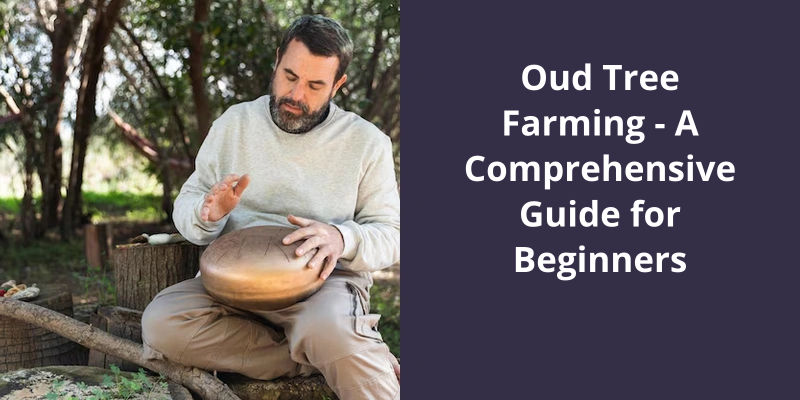Oud tree farming, also known as Agarwood farming, is a process that involves planting and nurturing the Aquilaria tree, a species known widely for its resinous heartwood. The heartwood is infected with a special type of mold, resulting in a dark and aromatic resin called oud or agarwood. The propagation of these trees takes place through seeds and they need a lot of care, including proper irrigation, use of pesticides, suitable weather and soil conditions, and regular pruning for a healthy growth cycle. However, patience is required in this farming as it takes around 5-7 years for the tree to get infected and start producing the precious resin. This oud resin has high demand in the perfume industry, while the wood is used in traditional medicine and religious rituals, making oud tree farming a lucrative business.

Can You Grow Agarwood in the US?
However, agarwood is an extremely slow-growing and difficult-to-cultivate tree that requires highly specific growing conditions to produce the precious resin. As such, agarwood cultivation in the US is an ongoing experimental process that’s still very much in it’s early stages.
While some nurseries in Southeast Asia and other parts of the world sell agarwood seedlings or saplings, these can be expensive and difficult to import. Additionally, some growers have reported issues with tree survival rates when transplanting agarwood from one environment to another, suggesting that it may be difficult to establish a sustainable supply of agarwood trees in the US.
Despite these challenges, there are some growers in the US who’re committed to cultivating agarwood and exploring it’s potential as a commercial crop. These growers have formed networks and organizations to share information and resources, and some have even formed partnerships with researchers and academics to better understand the complex biology of agarwood trees.
There’s also growing interest in agarwood among consumers and businesses in the US, with a number of companies now offering agarwood products such as oils, incense, and perfumes. While much of the agarwood used in these products is still sourced from Southeast Asia, some companies are looking to develop their own agarwood plantations in the US as a way to secure a local, sustainable supply of the resin.
The Traditional Uses and Cultural Significance of Agarwood in Asia and the Middle East, Where It Has Been Highly Valued for Centuries as an Ingredient in Perfumes, Medicines, and Religious Rituals.
- Agarwood has been used in traditional medicine in Asia and the Middle East for centuries, with claims of healing properties for various ailments.
- Agarwood is a common ingredient in incense and perfumes due to it’s distinct aroma, and it’s often burnt during religious ceremonies.
- In Asia, agarwood is also valued for it’s cultural significance and has been used in art and poetry.
- Agarwood trees are now endangered due to overharvesting, leading to the development of synthetic alternatives.
As we’ve learned, the process of agarwood formation in a natural environment can take up to a decade, which makes it an unpredictable and time-consuming process. However, with the development of new induction technology, it’s now possible to produce agarwood in a more controlled and efficient manner, leading to higher yields and stable production. Let’s explore this technology in more detail.
How Long Does It Take to Produce Agarwood?
Agarwood, also known as oud, is a highly valued fragrant wood that’s derived from the resinous heartwood of the Aquilaria tree. The formation of agarwood in natural environments is a very slow and complex process, which can take up to several years to happen. This happens when the tree is infected by fungi or bacteria, triggering the production of resin in the tree trunk, with the goal of protecting itself from the invading organism. This resin gradually accumulates over time, leading to the formation of olfactory compounds that generate the characteristic fragrances of agarwood.
This demand for agarwood has resulted in various approaches being used to accelerate the production of agarwood, including wounding the trees, using chemicals, and heating the trees.
However, the sustainability of these approaches has been challenged, as they often lead to the death of the tree or the production of an inferior quality agarwood, thus affecting both the environment and revenue of the farmers. As a solution, various domestication programs have been initiated to cultivate Aquilaria trees for mass propagation, with the aim of improving the efficiency and sustainability of agarwood production.
In addition to the domestication programs, research in the field of agarwood production has also been focused on improving the understanding of the biosynthesis of agarwood compounds, with the goal of developing better and more sustainable means of inducing agarwood formation. This is important not only for the production of agarwood but also for the conservation of endangered Aquilaria species which are threatened by over-harvesting and habitat destruction. As scientific breakthroughs continue to be made in the field of agarwood production, it’s hoped that the demand for agarwood can be met without having a negative impact on the environment or the livelihoods of local communities.
Growing Agarwood has become increasingly popular due to it’s high demand and profitability. With modern techniques, artificial inoculation has become a reliable method in cultivating Agarwood, allowing for faster and more efficient production. By selecting high-quality saplings and implementing proper care, growers can yield excellent results in their Agarwood plantation.
Can You Cultivate Agarwood?
Agarwood, also known as oud, is a highly valuable resinous wood that’s highly sought after for perfumes, incense, and medicinal purposes. Due to it’s increasing demand, the cultivation of agarwood has become a profitable business in many countries. It’s said that agarwood cultivation requires patience, skill, and knowledge of the right techniques.
The process of cultivating agarwood starts with selecting the right location for the plantation. The climate, soil quality, and altitude are the key factors that have to be considered before planting Agarwood trees. The ideal location for agarwood plantation is in tropical or subtropical areas, where the humidity is high, and the soil is well-drained.
Next, it’s important to choose the right saplings for the plantation. The saplings must be healthy, disease-free, and of good quality. It’s recommended to use artificial inoculation techniques for achieving agarwood in a short period of time. These techniques require the injection of a fungus on the trees, which initiates the production of agarwood. After the injection, the tree needs to be taken care of for some time to ensure healthy growth and resin production.
Therefore, it’s important to have a proper watering and fertilization schedule for the trees. Pests and diseases can cause serious damage to agarwood trees, so proper pest and disease control measures need to be taken.
As the trees mature, they start producing resinous wood, which is the prized product of the agarwood plantation. The resinous wood is harvested by cutting down the tree or by extracting the resin from the tree. The harvest should be done carefully, and the tree should be left to grow for some time before harvesting again. With proper care and management, a single agarwood tree can produce high-quality resin for many years.
Starting an agarwood plantation requires careful consideration and planning. One of the key factors to ensure a successful plantation is selecting the right land, including sloping lands to reduce mortality. Another crucial aspect is transplanting the seedlings at the right time and size, avoiding older seedlings with coiled roots in confined bags. In this article, we’ll delve into more details on how to start an agarwood plantation and the different aspects to consider.
How Do You Start Agarwood Plantation?
Agarwood, a highly sought-after tree species, is known for it’s distinctive aroma and is widely used in many industries, such as perfumery and aromatherapy. Establishing an agarwood plantation, however, can be a daunting task. Land with shallow slopes is ideal, as it allows for proper drainage and reduces the risk of waterlogging. If the soil is too heavy and compact, it can be mixed with sand and organic matter to improve it’s structure.
Once the location has been selected, a plan should be made for the plantation. It’s important to decide on the type of agarwood to be planted and the planting density. The seedlings are usually transplanted into the ground after reaching a height of 60-90 centimeters. This ensures that the seedlings are strong enough to survive once they’re planted in the field. Seedlings that are too old aren’t recommended due to the risk of root coiling in the poly bag if it isn’t big enough.
Before planting the seedlings, it’s important to prepare the soil by adding suitable fertilizers and organic matter. The spacing between the seedlings should be adequate to allow sunlight to pass through and wind to circulate freely. Proper irrigation facilities should also be put in place to ensure that the plants receive adequate water during dry spells.
The trees require regular pruning to maintain their shape and to encourage healthy growth. Weeding and pest control measures should also be implemented to prevent the plants from being damaged by insects and disease. Harvesting agarwood is also a complex process that requires expertise and specialized equipment.
Types of Agarwood That Are Suitable for Planting
Agarwood, also known as oud, is a fragrant wood that’s highly valued for it’s unique aroma. There are different types of agarwood that are suitable for planting depending on the climate and soil conditions. Some of the most common types include Aquilaria crassna, Aquilaria malaccensis, and Aquilaria sinensis. These trees require a warm and humid environment, well-drained soil, and proper care to produce high-quality agarwood.
Conclusion
While it’s true that the process of cultivating oud trees is slow and requires patience, the end result is a precious resin that’s highly sought after in various sectors. Additionally, this practice is deeply rooted in cultural and historical heritage, making it a powerful tool for preserving indigenous knowledge and promoting social cohesion.





